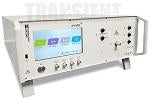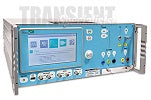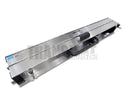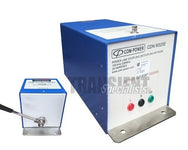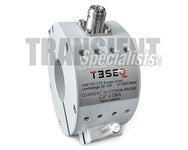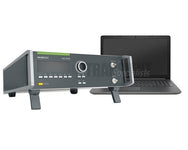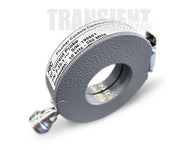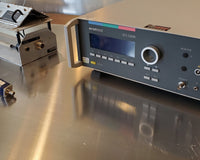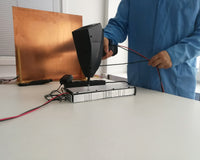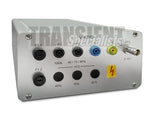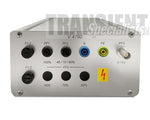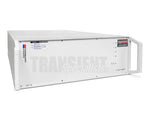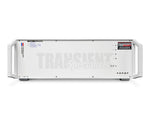Voltage Dips/Sags Overview
Voltage dips or sags as well as other power quality occurrences are not new events, however as more susceptible sensitive electronics and automated processes have been added to the power grid they have become more costly and require consideration during product development. These events impact both commercial and industrial customers connected to the power distribution grid impacting all connected devices.
Our discussion of voltage dips will focus on public supply networks and heavily on low-voltage distribution networks using IEC 61000-4-11, IEC 61000-2-8, and BS EN 50160 as references for the event and how it is tested. For additional information on this event please reference the resources/references below or EMCStandards which provides an excellent guide for IEC 61000-4-11 testing.
What are Voltage Dips or Sags?
When describing this event type of event, the terms voltage sag and voltage dips are used interchangeably. The term "sag" is most commonly used in the US and IEEE while in Europe and other parts of the world "dip" is more commonly used(1).
Voltage Dips/Sags Concept

This disturbance in power supply networks is commonly defined by the percentage decrease in voltage and time or number of cycles. The associated image illustrates a voltage dip of 70% of the RMS voltage over 10 cycles.
The timing involved in this event can vary from a 1/2 cycle to one minute, with dips longer than one minute being categorized as an under-voltage based upon EN 50160 and IEC 61000-4-30. The time associated with this event is commonly determined by how long it takes for the protective device to clear the over-current condition, commonly up to 10 cycles.(2)
Sources of Voltage Dips
The primary sources for a variety of different AC power quality-related issues including dips, swells, voltage variations, and dropouts come from load switching, faults, and motors starting. Low voltage, high voltage, and medium voltage three-phase distribution systems are all potential sources of these power quality issues.
What causes a voltage dip or sag?

Faults in the three-phase distribution systems can lead to voltage drops across all three phases, or if the fault is nonsymmetrical across any number of the phases. For additional information on both unbalanced and balanced voltage dips in three-phase systems, Mathe H. J. Bollen's paper does an excellent job of explaining further.
Faults and short circuits can be caused by a variety of different occurrences from both external factors and wear over time of electrical components. This can be seen in the breakdown of dielectric material designed as insulation between materials with different potentials. Other potential causes include:
- atmospheric events
- mechanical interference and damage
- breakdown of network plant
- accidents or errors in operation and maintenance
- major natural events

Magnitude & Duration of Event

As mentioned previously this occurrence is defined by the magnitude in percentage of normal RMS voltage and duration in time (typically in number of cycles). These two criteria will vary based upon the severity and location of the fault within the electrical system supply and the speed of the operation of protective devices (fused, relays, etc.).
Voltage Dip Magnitude/Depth
The voltage Depth is provided by BS EN 50160 as "The depth of a voltage dip is defined as the difference between the minimum rms voltage during the voltage dip and the declared voltage". This is relayed as a percentage of the normal r.m.s. voltage as shown above.
The values of the dips can vary based on the proximity to the short circuit while factoring in impedance considerations. IEC 61000-2-8: 2002-11 in section 3.3 provides a circuit representation illustrating this further. There is also the potential that connected equipment which can either store or generate energy to impact the depth of the voltage decrease.

Given the importance the proximity of the fault has in relation to the magnitude of the voltage dips, the type of power line also has an impact on the severity of the voltage decrease. As illustrated in the associated image, electrical shorts which occur in the larger transmission systems have the potential to impact a wider area than that of the small distribution systems. In situations where the short occurs in the distribution system, there will be a much smaller area of influence, at longer distances the dip may hardly be noticed.
Voltage Dip Duration or Timing
The duration (either in minutes or cycles) is determined by the speed of the protection devices or the self-clearing fault. Many short circuits are cleared in 100 ms to 500 ms with longer times in distribution circuits. Events or faults other than short circuits will typically vary in relation to the event.
How long does a voltage sag last?
When we evaluate voltage dips the way that the timing or duration of the event can differ by requirements. EN 50160 defines the timing of a voltage drop between 90% and 1% by:
- Events below ½ cycle are transients (not recorded)
- Events from ½ cycle to 30 cycles are instantaneous dips
- Events from 30 cycles to 3 seconds are momentary dips
- Events from 3 seconds to one minute are temporary dips
- above one minute, it’s under-voltage (different event)(3)
IEC 61000-4-11 which is a generic product immunity test standard describes the timing of the events in the number of cycles, as opposed to the number of cycles and minute combination. Referencing table one for preferred test level and duration for voltage dips, the cycles begin at 1/2 cycle and go upwards to 300 cycles. Converting 300 cycles AC at 60 Hz (US power frequency) to seconds using a units converter, brings the time in seconds to roughly 5 seconds.
When looking at both standards, there is a noticeable difference in the longer duration dips, with EN 50160 defining up to one minute. IEC 61000-4-11 also does not categorize the dips into subcategories in instantaneous, momentary, and temporary categories.
Voltage Dips and Short Interruptions
IEC 61000-4-11 and IEC 61000-2-8 describe voltage dips as low as 0% of the nominal voltage, this would imply that it is a short interruption while a connection is maintained. The distinction between a voltage dip and short interruption by the IEC is based upon the connection to the voltage source rather than the 0% level. This can be seen in a 0% test level being present at a 1/2 cycle in IEC 61000-4-11 while also a 0% being present in short interruptions testing at 250/300 cycles.
Dips Extent & Effects
The extent to which voltage dips occur in public distribution systems can vary significantly from one part of the country to another, as well as by different parts of the power grid. When evaluating the impact on the distribution network it is typical to see over 50 events a year where a voltage drop below 90% which impacts the customer(7).
Extent Statistics(4)

While there are many different measurements that have been collected on this occurrence the EPRI survey is of note. This occurred between 1993 and 1995 and monitored 34 utilities in the US, monitories were in stalled in 227 sites on 95 different feeders. These different feeder locations varied in voltage from 4 to 33 kV and were placed to represent the range of characteristics seen in the US power distribution systems.
The results shown in the histogram on the right illustrates number of dips and interruptions per site per 30 days. It is worth noting the increasing rate of sags and interruptions as the RMS voltage magnitude increases.
Voltage Dips Effects
The effects can be caused by the drop in voltage or the corresponding decrease in energy capacity available for use by the equipment. This is particularly important in complex processes including those in manufacturing where systems downtime or errors in production can have significant financial losses.
IEC 61000-4-11 Dips Testing
IEC 61000-4-11 is a generic immunity testing standard used to evaluate the impact of dips or sags (as well as other power quality events) on equipment 16 Amps or less connected to 50 Hz or 60 Hz power networks. This standard specifies a variety of different criteria including timing, duration, classifications, and performance criteria which are used to describe the impact on the equipment under test or EUT.
This video illustrates how dips testing is conducted with the EM Test NX7 and V 4780 transformer it includes:
- V 4780 dips transformer overview
- EM Test setup for IEC 61000-4-11
- Selecting dips testing criteria
- Running 40% dips test
- Basic verification of voltage decrease
Test Overview
The goal of this standard is to evaluate the impact of voltage dips as well as short interruptions and voltage variations has on equipment connected to public distribution networks. The goal is to determine if the equipment under test (EUT) has a robust enough design to withstand, or immunity, to these power quality-related events.
This standard breaks down test results into four different categories in an effort to determine the impact that voltage dips have on the EUT.(5)
- Performance Criteria A – ‘Performance within specification limits
- Performance Criteria B – ‘Temporary degradation which is self-recoverable’
- Performance Criteria C – ‘Temporary degradation which requires operator intervention’
- Performance Criteria D – ‘Loss of function which is not recoverable’

There are some unique requirements that are worth taking note of in IEC 61000-4-11 in regard to the equipment used for testing(6), verification of peak inrush Current, 1 us to 5 us rise and fall times, and test levels 0%, 40%, 70%, & 80%. A compliant solution for testing will typically include a power supply and a transformer or variac, with the transformer or variac providing the fast risetimes by the standard. A basic illustration of the test concept using equipment can be seen in the illustration to the right

Voltage Dips/Sags FAQ
Resources/References Information
https://slpower.com/App-slpower/images/whitepapers/AN144%20EN61000-4-11.pdf
https://www.se.com/ww/library/SCHNEIDER_ELECTRIC/SE_LOCAL/APS/204836_1312/DraftStandard0026rev2-DraftEN501602005-05.pdf
Voltage Dips and Variations Testing – Atlas Compliance & Engineering. (n.d.). https://atlasce.com/services/immunity-testing/voltage-dips-and-variations-testing/
Applying Voltage Dip Proofing to Provide Ride-Through - For Facilities During Momentary Power Interruptions & Voltage Sags. (n.d.-b). Electric Energy Online. https://electricenergyonline.com/energy/magazine/81/article/Applying-Voltage-Dip-Proofing-to-Provide-Ride-Through.htm
Posts, V. M. (2021, September 8). Statistical Analysis of Voltage Dips and Interruptions – Final Results From the EPRI Distribution System Power Quality Monitoring Survey. Power Quality Blog. https://powerquality.blog/2021/09/08/statistical-analysis-of-voltage-dips-and-interruptions-final-results-from-the-epri-distribution-system-power-quality-monitoring-survey/
Mill, S. (2014, July 28). ▷ Impacts of Voltage Dips on Power Quality Problems. Electrical Equipment. https://engineering.electrical-equipment.org/power-quality/impacts-of-voltage-dips-on-power-quality-problems.html
Elspec, & Elspec. (2023). What are Voltage Sags (Dips) and Swells | Elspec. Elspec. https://www.elspec-ltd.com/what-are-voltage-sags-and-swells/#
https://www.pge.com/includes/docs/pdfs/mybusiness/customerservice/energystatus/powerquality/voltagesags.pdf
(1)Yepyep. (n.d.). POWER QUALITY BASICS: VOLTAGE SAGS OR DIPS. Power Quality in Electrical Systems. http://www.powerqualityworld.com/2011/03/voltage-sags-dips-power-quality-basics.html
(2)https://www.pge.com/includes/docs/pdfs/mybusiness/customerservice/energystatus/powerquality/voltagesags.pdf(3)LaoRen. (2023). What is a Voltage Dip Event? CLOU GLOBAL. https://clouglobal.com/what-is-a-voltage-dip-event/
(4)SABIN, DD. et al., RMS Voltage Variation Statistical Analysis for a Survey of
Distribution System Power Quality Performance. IEEE, 1998, IEEE paper no. 0-7803-
4403-0/98.
(5)https://slpower.com/App-slpower/images/whitepapers/AN144%20EN61000-4-11.pdf
(6)Keeton, G. (n.d.). Introduction to IEC 61000-4-11, Part II - AC source requirements. https://blog.programmablepower.com/blog/introduction-to-iec-61000-4-11-part-ii-ac-source-requirements
(7)Applying Voltage Dip Proofing to Provide Ride-Through - For Facilities During Momentary Power Interruptions & Voltage Sags. (n.d.-c). Electric Energy Online. https://electricenergyonline.com/energy/magazine/81/article/Applying-Voltage-Dip-Proofing-to-Provide-Ride-Through.htm




